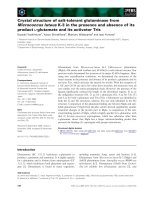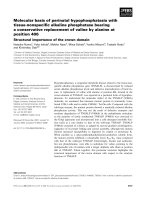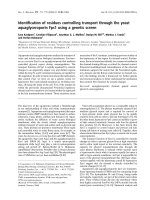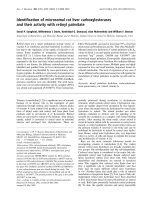báo cáo khoa học: " High prevalence of HIV infection among homeless and street-involved Aboriginal youth in a Canadian setting" potx
Bạn đang xem bản rút gọn của tài liệu. Xem và tải ngay bản đầy đủ của tài liệu tại đây (227.79 KB, 5 trang )
BioMed Central
Page 1 of 5
(page number not for citation purposes)
Harm Reduction Journal
Open Access
Brief report
High prevalence of HIV infection among homeless and
street-involved Aboriginal youth in a Canadian setting
Brandon DL Marshall
1,2
, Thomas Kerr
1,3
, Chris Livingstone
4
, Kathy Li
1
,
Julio SG Montaner
1,3
and Evan Wood*
1,3
Address:
1
British Columbia Centre for Excellence in HIV/AIDS, St. Paul's Hospital, 608-1081 Burrard Street, Vancouver, BC, V6Z 1Y6, Canada ,
2
School of Population and Public Health, University of British Columbia, 5804 Fairview Avenue, Vancouver, BC, V6T 1Z3, Canada ,
3
Department
of Medicine, University of British Columbia, St. Paul's Hospital, 608-1081 Burrard Street, Vancouver, BC, V6Z 1Y6, Canada and
4
Western
Aboriginal Harm Reduction Society, 380 East Hastings Street, Vancouver, BC, V6A 1P4, Canada
Email: Brandon DL Marshall - ; Thomas Kerr - ; Chris Livingstone - ;
Kathy Li - ; Julio SG Montaner - ; Evan Wood* -
* Corresponding author
Abstract
Aboriginal people experience a disproportionate burden of HIV infection among the adult
population in Canada; however, less is known regarding the prevalence and characteristics of HIV
positivity among drug-using and street-involved Aboriginal youth. We examined HIV
seroprevalence and risk factors among a cohort of 529 street-involved youth in Vancouver,
Canada. At baseline, 15 (2.8%) were HIV positive, of whom 7 (46.7%) were Aboriginal. Aboriginal
ethnicity was a significant correlate of HIV infection (odds ratio = 2.87, 95%CI: 1.02 – 8.09). Of the
HIV positive participants, 2 (28.6%) Aboriginals and 6 (75.0%) non-Aboriginals reported injection
drug use; furthermore, hepatitis C co-infection was significantly less common among Aboriginal
participants (p = 0.041). These findings suggest that factors other than injection drug use may
promote HIV transmission among street-involved Aboriginal youth, and provide further evidence
that culturally appropriate and evidence-based interventions for HIV prevention among Aboriginal
young people are urgently required.
Background
Aboriginal populations in Canada are contending with a
disproportionate burden of HIV infection [1]. Although
only 3.3% of Canadians identify as American Indian, First
Nations, Inuit, or Métis, Aboriginal people accounted for
18.8% of HIV test reports in 1998 and 27.3% in 2006
[1,2]. Within adult Aboriginal communities, injection
drug use is considered to be one of the primary modes of
HIV transmission, accounting for approximately 60% of
new HIV infections [1]. Among injection drug using pop-
ulations, Aboriginal ethnicity has also been shown to be
an independent predictor of HIV seroconversion [3,4].
Elevated rates of HIV incidence have also been observed
among young Aboriginal injection drug users [5,6].
Although the prevalence and risk factors for HIV infection
among Aboriginal injection drug users have been rela-
tively well-described, there exists little information on
HIV infection among populations of street-involved Abo-
riginal youth with heterogeneous (i.e., injection and non-
injection) drug-using characteristics and patterns. Since
HIV infections typically occur at earlier ages among Abo-
riginal people as compared to the non-Aboriginal popula-
tion [1], research examining the risk factors for HIV
infection among this age group is of particular salience to
Published: 19 November 2008
Harm Reduction Journal 2008, 5:35 doi:10.1186/1477-7517-5-35
Received: 6 October 2008
Accepted: 19 November 2008
This article is available from: />© 2008 Marshall et al; licensee BioMed Central Ltd.
This is an Open Access article distributed under the terms of the Creative Commons Attribution License ( />),
which permits unrestricted use, distribution, and reproduction in any medium, provided the original work is properly cited.
Harm Reduction Journal 2008, 5:35 />Page 2 of 5
(page number not for citation purposes)
public health programming and policy. We undertook
this study to examine the prevalence and characteristics of
HIV positive status among a cohort of street-involved
youth in Vancouver.
Methods
The At Risk Youth Study (ARYS) is a prospective cohort of
drug-using and street-involved youth that has been
described in detail previously [7]. Snowball sampling and
extensive street-based outreach was conducted to recruit
participants into the study. Eligibility criteria included:
being between the age of 14 and 26, self-reported use of
illicit drugs other than or in addition to marijuana in the
past 30 days, and the provision of informed consent. The
study has been approved by the University of British
Columbia/Providence Health Care Research Ethics Board.
We also sought to ensure that the research protocols were
in accordance with the Canadian Institutes of Health
Research Guidelines for Health Research Involving Aboriginal
People [8].
All participants who completed a baseline survey between
September, 2005 and October, 2006 were included in this
analysis. At study entry, each participant completed an
interviewer-administered questionnaire and provided
blood samples for HIV and hepatitis C (HCV) serology.
American Indian/Aboriginal ethnicity (yes vs. no) was
defined as self-identified First Nations, Aboriginal, Inuit,
or Métis origin. Other variables that were included in this
analysis included age (<22 vs. ≥ 22), sex (female vs. male),
Downtown Eastside (DTES) residency, homelessness,
injection drug use, syringe sharing, history of incarcera-
tion, history of sex work, history of sexual abuse, ever
engaging in anal intercourse, condom use (inconsistent
vs. consistent), and for males, ever engaging in sex with
men. As described previously [9], individuals were
recorded as residents of the Downtown Eastside if they
responded "DTES" to the question, "What local neigh-
bourhoods or cities have you lived in during the past 6
months". Individuals classified as DTES residents may
include those who are homeless and sleep or spend most
of their time in the neighbourhood. To be consistent with
previous studies, syringe sharing included lending or bor-
rowing used syringes, and inconsistent condom use was
defined as not always using a condom during vaginal and
anal intercourse with all regular and casual partners
[10,11].
Pearson's chi-square test was used to determine the factors
associated with HIV positive status at baseline (Table 1).
Fisher's exact test was used when one or more of the cell
counts was less than or equal to five. Since we only
observed 15 positive diagnoses, multivariate analysis was
not conducted; however, the individual characteristics of
each HIV positive participant were aggregated and are pre-
sented in Table 2.
Findings
A total of 529 participants completed a baseline survey
and were eligible for this analysis. The median age of the
sample was 22.0 (interquartile range: 19.9 – 23.9), 159
(30.1%) were female, 404 (76.4%) had been homeless in
the past six months, and 221 (41.8%) reported ever inject-
ing. In total, 127 (24.0%) participants self-identified as
Aboriginal, American Indian, First Nations, Inuit, or
Métis.
Of the entire sample, 15 (2.8%) tested positive for HIV, of
whom 7 (46.7%) were of Aboriginal ethnicity. As shown
in Table 1, Aboriginal ethnicity was associated with HIV
infection (odds ratio [OR] = 2.87, 95%CI: 1.02 – 8.09), as
was injection drug use (OR = 2.75, 95%CI: 0.98 – 7.73)
and sex trade work (OR = 4.35, 95%CI: 1.54 – 12.26).
Younger participants were less likely to be infected with
HIV (OR = 0.14, 95%CI: 0.03 – 0.65).
Among the HIV positive individuals (Table 2), only 2
(28.6%) Aboriginal participants reported injecting drugs
and none reported sharing syringes. HIV-infected Aborig-
inal youth were significantly less likely to be co-infected
with HCV (Fisher's exact test p-value = 0.041).
Discussion
Among a community-based sample of street-involved
youth, Aboriginal participants were more than two and a
half times more likely to be infected with HIV. The preva-
lence of HIV among Aboriginal youth in this sample was
5.5%, a proportion similar to that reported in a recent
study of at-risk Aboriginal youth in two cities in British
Columbia [12]. The prevalence of HIV among Aboriginal
youth in this setting is also substantially higher than those
that have been observed among street youth populations
in Montréal (1.9%) and Toronto (2.2%) [13,14]. Further-
more, the fact that HIV-infected Aboriginal youth were
less likely to report injection drug use and be co-infected
with HCV suggests that unsafe sexual activity, sex work,
and other unmeasured antecedent factors may be respon-
sible for a significant proportion of infections. These find-
ings are concerning and suggest that immediate and
culturally appropriate policy and programmatic remedies
are required to prevent further infections among Aborigi-
nal youth and to provide increased resources to those
individuals who are already infected.
Other factors that were associated with HIV positivity in
bivariate analysis are similar to other studies of HIV infec-
tion among street-involved youth in Canada. For exam-
ple, older age, history of injection drug use, and sex work
were also all significant correlates of HIV infection among
Harm Reduction Journal 2008, 5:35 />Page 3 of 5
(page number not for citation purposes)
a cohort of street-involved youth in Montreal [14]. Of par-
ticular relevance to our setting is the high prevalence of
incarceration observed among both HIV positive and neg-
ative participants – in fact, all seven HIV positive Aborigi-
nal individuals also reported a history of incarceration.
Given that incarceration has been associated with both
HIV risk behaviours [15] and HIV incidence [16] in Van-
couver, interventions to reduce street youths' exposure to
correctional environments and the HIV-related harms
associated with them are in urgent need of evaluation. Of
further concern is that over half of HIV-infected Aborigi-
nal participants reported experiencing sexual abuse, a
finding which supports a recent study showing strong
associations between sexual abuse and HIV risk behav-
iours among this population [17]. These results suggest
that programs which aim to support HIV positive Aborig-
inal young people should recognize and address the last-
ing effects of historical trauma and cultural assimilation
stemming from the Canadian residential school system
on current levels of sexual abuse, substance use, and other
HIV-related vulnerabilities.
Recently, the federal government of Canada announced
that funding to community and regional HIV programs
would be redirected towards the Canadian HIV Vaccine
Initiative [18,19]. Although research funding for HIV vac-
Table 1: Factors associated with HIV seropositive status among a cohort of homeless and street-involved youth (n = 529)
Characteristic HIV Positive
n (%)
n = 15
HIV Negative
n (%)
n = 514
Odds Ratio
(95% CI)
p-value
Age
< 22 2 (13.3) 265 (51.6) 0.14 (0.03 – 0.65) 0.003
≥ 22 13 (86.7) 249 (48.4)
Sex
Female 5 (33.3) 153 (29.8) 1.18 (0.40 – 3.51) 0.778
Male 10 (66.7) 361 (70.2)
Aboriginal Ethnicity
Yes 7 (46.7) 120 (23.3) 2.87 (1.02 – 8.09) 0.037
No 8 (53.3) 394 (76.7)
DTES Residency
†
Yes 4 (26.7) 139 (27.0) 0.98 (0.31 – 3.13) 1.000
No 11 (73.3) 375 (73.0)
Homeless
†
Yes 11 (73.3) 393 (76.5) 0.85 (0.26 – 2.71) 0.761
No 4 (26.7) 121 (23.5)
Injection Drug Use
†
Yes 8 (53.3) 151 (29.4) 2.75 (0.98 – 7.73) 0.046
No 7 (46.7) 363 (70.6)
Syringe Sharing
†
Yes 3 (20.0) 45 (8.8) 2.59 (0.70 – 9.56) 0.148
No 12 (80.0) 467 (91.2)
Incarceration
‡
Yes 11 (73.3) 382 (74.3) 0.95 (0.30 – 3.04) 1.000
No 4 (26.7) 132 (25.7)
Sex Work
‡
Yes 8 (53.3) 107 (20.8) 4.35 (1.54 – 12.26) 0.003
No 7 (46.7) 407 (79.2)
Sexual Abuse
‡
Yes 6 (42.9) 132 (26.0) 2.13 (0.73 – 6.23) 0.271
No 8 (57.1) 375 (74.0)
MSM
‡
Yes 2 (13.3) 33 (6.4) 2.24 (0.49 – 10.36) 0.261
No 13 (86.7) 481 (93.6)
Anal Intercourse
‡
Yes 5 (33.3) 149 (29.0) 1.22 (0.41 – 3.64) 0.774
No 10 (66.7) 365 (71.0)
Condom Use*
†
Inconsistent 4 (57.1) 284 (69.6) 0.58 (0.13 – 2.65) 0.442
Consistent 3 (42.9) 124 (30.4)
Note: † – refers to activities in the past 6 months; ‡ – refers to lifetime history; * – among sexually active participants
Harm Reduction Journal 2008, 5:35 />Page 4 of 5
(page number not for citation purposes)
cines is undoubtedly integral to long-term HIV strategies,
the observed prevalence of HIV among Aboriginal youth
observed in this and other studies supports statements
made by the Assembly of First Nations that, relative to the
size of the epidemic, HIV programs for Aboriginal pro-
grams are chronically under-funded and are in urgent
need of further investment [20]. The Canadian Aboriginal
AIDS Network has also argued that a serious lack of youth-
specific HIV prevention programmes for Aboriginal youth
exists across the country, and as such a national strategy
on Aboriginal youth HIV/AIDS prevention is required
[21]. Given these concerns, research and interventions
that seek to identify effective strategies for addressing HIV
infection and related vulnerabilities among Aboriginal
young people should be a public health priority.
Our study is limited by its nonrandom sampling method-
ology that precludes generalization to the larger street-
involved population in British Columbia. However, the
sociodemographic characteristics of our sample are simi-
lar to those observed among other street youth studies in
this setting [22,23]. Secondly, stigmatized behaviours
such as injection drug use and syringe sharing may be
underreported, particularly as the reliability and validity
of self-report among samples of Aboriginal youth has
been questioned by some authors [24]. However, a review
of studies assessing the reliability and validity of self-
reported drug use and HIV risk behaviours among injec-
tion drug users concluded that these measures are suffi-
ciently valid [25]. It is also important to note that the
prevalence of injection drug use and related behaviours
reported in our study are similar to those from a recently
published analysis of risk behaviours among Aboriginal
youth who use drugs in Vancouver [12]. Even if socially
desirable reporting were present in the data, we have no
reason to believe that Aboriginal and non-Aboriginal par-
ticipants would differ with respect to the likelihood of the
underreporting of certain behaviours. Furthermore, it is
noteworthy that biological evidence (i.e., hepatitis C
serostatus) supports the self-reported data suggesting a
higher proportion of sexually acquired HIV among Abo-
riginal participants. Finally, although we recognize that
HIV vulnerability among Aboriginal populations is pro-
duced through a complex interplay of social, structural,
and historical factors such as poverty, cultural oppression,
and the multigenerational effects of the residential school
system [6], we were unable to measure and characterize
many of these effects.
In summary, we observed an alarmingly high prevalence
of HIV infection among street-involved Aboriginal youth.
Our findings demonstrate that urgent and culturally
appropriate action is required to address the pervasive
inequities that perpetuate marginalization and height-
ened vulnerability to HIV among Aboriginal young peo-
ple in Canada.
Competing interests
BM, TK, CL, KL, and EW declare that they have no compet-
ing interests. JM has received grants from, served as an ad
hoc adviser to, or spoken at events sponsored by Abbott,
Argos Therapeutics, Bioject Inc., Boehringer Ingelheim,
BMS, Gilead Sciences, GlaxoSmithKline, Hoffmann-La
Roche, Janssen-Ortho, Merck Frosst, Panacos, Pfizer,
Schering, Serono Inc., TheraTechnologies, Tibotec (J&J),
and Trimeris.
Authors' contributions
EW had full access to all of the data and takes responsibil-
ity for the integrity of the results and the accuracy of the
statistical analysis. BM conceived the study concept and
design and was responsible for the composition of the
manuscript.
The statistical analysis was conducted by KL and the inter-
pretation of the results was performed by BM, CL, EW, JM
and TK. The manuscript was edited and revised by BM, CL,
EW, JM and TK. All authors read and approved the final
manuscript.
Acknowledgements
We would particularly like to thank the ARYS participants for their willing-
ness to be included in the study, as well as current and past ARYS investi-
gators and staff. We would specifically like to thank Deborah Graham,
Tricia Collingham, Leslie Rae, Caitlin Johnston, Steve Kain, and Calvin Lai
for their research and administrative assistance. The study was supported
by the US National Institutes of Health and the Canadian Institutes of
Health Research (CIHR). Brandon Marshall is supported by training awards
from the Michael Smith Foundation for Health Research (MSFHR) and
CIHR. Thomas Kerr is supported by fellowships from MSFHR and CIHR.
Table 2: Characteristics of HIV positive homeless and street-
involved youth (n = 15).
Characteristic Aboriginal
n (%)
n = 7
Non-Aboriginal
n (%)
n = 8
Age < 22 1 (14.3) 1 (12.5)
Female 3 (42.9) 2 (25.0)
DTES Residency
†
3 (42.9) 1 (12.5)
Homeless
†
5 (71.4) 6 (75.0)
Injected Drugs
†
2 (28.6) 6 (75.0)
Shared Syringes
†
0 (0.0) 3 (37.5)
Incarceration
‡
7 (100.0) 5 (62.5)
Sex Work
‡
4 (57.1) 4 (50.0)
Sexual Abuse
‡
4 (57.1) 2 (25.0)
MSM
‡
2 (28.6) 0 (0.0)
Anal Intercourse
‡
2 (28.6) 3 (37.5)
Inconsistent Condom Use
†
2 (28.6) 2 (25.0)
Hepatitis C Infection 1 (14.3) 6 (75.0)
Note: † – refers to activities in the past 6 months; ‡ – refers to
lifetime history;
Publish with Bio Med Central and every
scientist can read your work free of charge
"BioMed Central will be the most significant development for
disseminating the results of biomedical research in our lifetime."
Sir Paul Nurse, Cancer Research UK
Your research papers will be:
available free of charge to the entire biomedical community
peer reviewed and published immediately upon acceptance
cited in PubMed and archived on PubMed Central
yours — you keep the copyright
Submit your manuscript here:
/>BioMedcentral
Harm Reduction Journal 2008, 5:35 />Page 5 of 5
(page number not for citation purposes)
References
1. Public Health Agency of Canada: HIV/AIDS Epi Updates, Novem-
ber 2007. [ />epi2007_e.pdf].
2. Public Health Agency of Canada: Understanding the HIV/AIDS
Epidemic among Aboriginal Peoples in Canada: The Com-
munity at a Glance. [ />aepi/epi-note/pdf/epi_notes_aboriginal_e.pdf].
3. Wood E, Montaner JS, Li K, Zhang R, Barney L, Strathdee SA, Tyndall
MW, Kerr T: Burden of HIV infection among Aboriginal injec-
tion drug users in Vancouver, British Columbia. Am J Public
Health 2008, 98:515-519.
4. Craib KJ, Spittal PM, Wood E, Laliberte N, Hogg RS, Li K, Heath K,
Tyndall MW, O'Shaughnessy MV, Schechter MT: Risk factors for
elevated HIV incidence among Aboriginal injection drug
users in Vancouver. CMAJ 2003, 168:19-24.
5. Miller CL, Tyndall M, Spittal P, Li K, LaLiberte N, Schechter MT: HIV
incidence and associated risk factors among young injection
drug users. AIDS 2002, 16:491-493.
6. Miller CL, Strathdee SA, Spittal PM, Kerr T, Li K, Schechter MT,
Wood E: Elevated rates of HIV infection among young Abo-
riginal injection drug users in a Canadian setting. Harm Reduct
J 2006, 3:9.
7. Wood E, Stoltz JA, Montaner JS, Kerr T: Evaluating methamphet-
amine use and risks of injection initiation among street
youth: The ARYS study. Harm Reduct J 2006, 3:18.
8. Canadian Institutes of Health Research: Guidelines for Health
Research Involving Aboriginal People. [r-
irsc.gc.ca/e/documents/ethics_aboriginal_guidelines_e.pdf].
9. Maas B, Fairbairn N, Kerr T, Li K, Montaner JS, Wood E: Neighbor-
hood and HIV infection among IDU: Place of residence inde-
pendently predicts HIV infection among a cohort of injection
drug users. Health Place 2007, 13:432-439.
10. Marshall BDL, Kerr T, Shoveller JA, Patterson TL, Buxton JA, Wood
E: Homelessness and unstable housing associated with an
increased risk of HIV and STI transmission among street-
involved youth. 2008 in press.
11. Kerr T, Tyndall M, Li K, Montaner J, Wood E: Safer injection facil-
ity use and syringe sharing in injection drug users. Lancet
2005, 366:316-318.
12. Spittal PM, Craib KJP, Teegee M, Baylis C, Christian WM, Moniruzza-
man AKM, Schechter MT, Partnership CP: The Cedar Project:
Prevalence and correlates of HIV infection among young
Aboriginal people who use drugs in two Canadian cities. Int J
Circumpolar Health 2007, 66:226-240.
13. DeMatteo D, Major C, Block B, Coates R, Fearon M, Goldberg E, King
SM, Millson M, O'Shaughnessy M, Read SE: Toronto street youth
and HIV/AIDS: Prevalence, demographics, and risks. J Adolesc
Health 1999, 25:358-366.
14. Roy E, Haley N, Leclerc P, Lemire N, Boivin JF, Frappier JY, Claessens
C: Prevalence of HIV infection and risk behaviours among
Montreal street youth. Int J STD AIDS 2000, 11:241-247.
15. Milloy MJ, Wood E, Small W, Tyndall M, Lai C, Montaner J, Kerr T:
Incarceration experiences in a cohort of active injection drug
users. Drug Alcohol Rev 2008:1-7.
16. Tyndall MW, Currie S, Spittal P, Li K, Wood E, O'Shaughnessy MV,
Schechter MT: Intensive injection cocaine use as the primary
risk factor in the Vancouver HIV-1 epidemic. AIDS 2003,
17:887-893.
17. Cedar Project P, Pearce ME, Christian WM, Patterson K, Norris K,
Moniruzzaman A, Craib KJ, Schechter MT, Spittal PM: The Cedar
Project: Historical trauma, sexual abuse and HIV risk among
young Aboriginal people who use injection and non-injection
drugs in two Canadian cities. Soc Sci Med 2008, 66:2185-2194.
18. Galloway G: Ottawa redirects AIDS funds for Gates initiative.
Globe and Mail, National edition. November 29, 2007 :A1.
19. Public Health Agency of Canada: CPHO Statement on HIV/AIDS
Funding. [ />eng.php].
20. Assembly of First Nations: Canada's First Nations HIV/AIDS
Epidemic. [ />].
21. Prentice T, Norton A, Amaral A, Harper R, Unrau D, Myrah J, Nyce
FB, Jackson B, Barlow K: A community-based approach to
developing HIV prevention messages for Canadian Aborigi-
nal youth [abstract]. Can J Infect Dis 2004, 15:488P.
22. Martin I, Lampinen TM, McGhee D: Methamphetamine use
among marginalized youth in British Columbia. Can J Public
Health 2006, 97:320-324.
23. Ochnio JJ, Patrick D, Ho M, Talling DN, Dobson SR: Past infection
with hepatitis A virus among Vancouver street youth, injec-
tion drug users and men who have sex with men: Implica-
tions for vaccination programs. CMAJ 2001, 165:293-297.
24. Majumdar BB, Chambers TL, Roberts J: Community-based, cul-
turally sensitive HIV/AIDS education for Aboriginal adoles-
cents: Implications for nursing practice. J Transcult Nurs 2004,
15:69-73.
25. Darke S: Self-report among injecting drug users: A review.
Drug Alcohol Depend 1998, 51:253-263.









